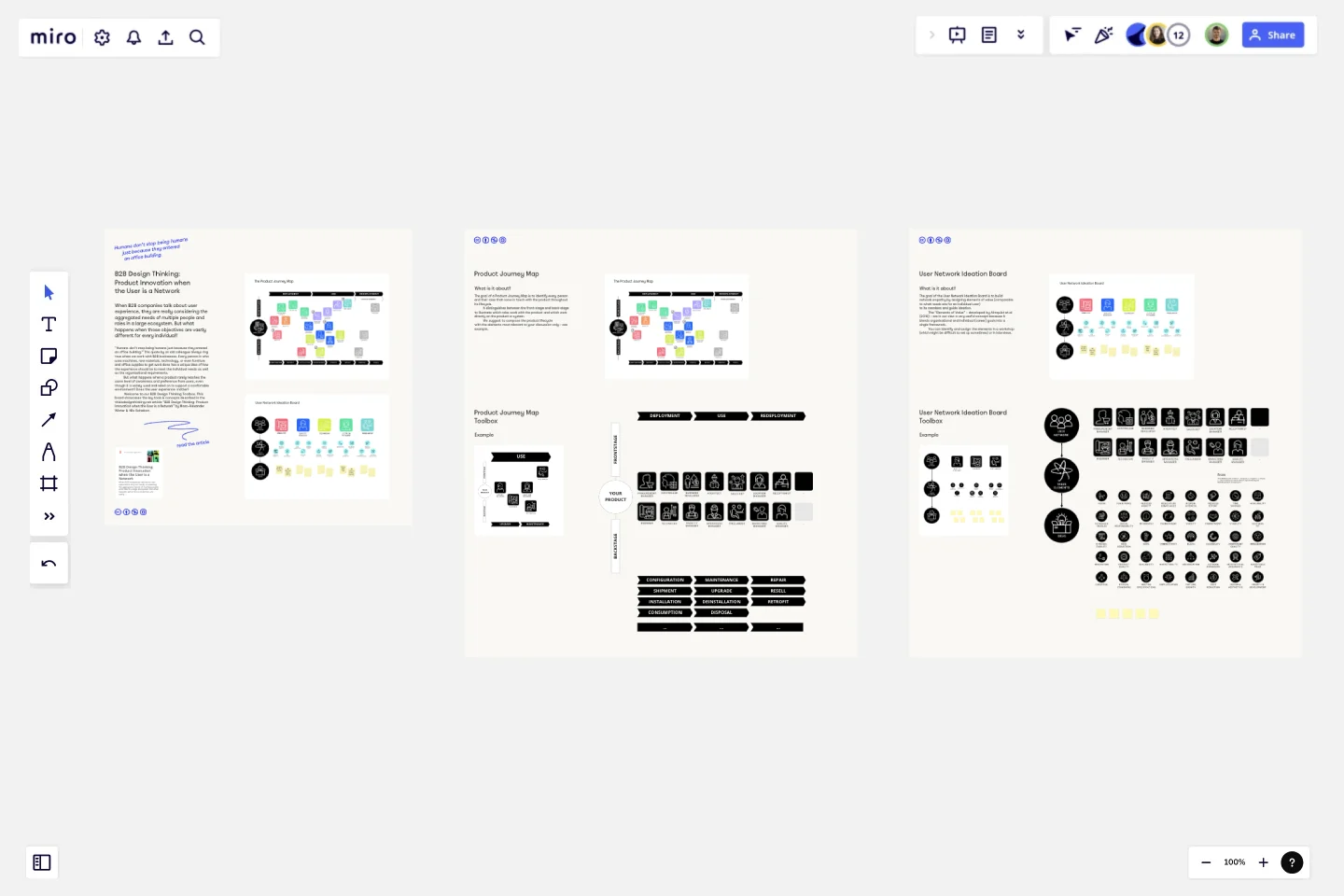B2B – Product Journey Map & User Network
B2B Design Thinking: Product Innovation when the User is a Network
Why do I need this?
When B2B companies talk about user experience, they are really considering the aggregated needs of multiple people and roles in a large ecosystem. These objectives can differ vastly for every individual. Because every person who uses machines, raw materials, technology, or even furniture and office supplies to get work done has a unique idea of how the experience should be like to meet their individual needs as well as the demands of the business.
Often though in B2B environments a product reaches less of the level of awareness and preference from users compared to B2C, even though it is widely used and relied on to support a comfortable environment. This is why we believe the user experience does matter also in B2B.
What is it?
To tackle this complex challenge we have developed two tools: the “Product Journey Map” and the “User Network Ideation Board”. They can help you to:
map known and unknown users along the journey of a product.
develop ideas in relation to their values typically embraced in the context of an organisation.
How do I use it? – The Product Journey Map
The goal of the Product Journey Map is to identify every person and their roles that come in touch with the product throughout its lifecycle. It distinguishes between the front-stage and back-stage to illustrate which roles work with the product and which work directly on the product or system.
Step 1 – Compose the product lifecycle with the elements most relevant to your case only. Have a bigger picture with main steps from the user’s perspective of the lifecycle on the top and a more detailed one with the internal process steps on the bottom.
Step 2 – Now define users that are relevant and come in touch with the product throughout the defined steps. Look for users that work with the product. These should be place towards the frontstage. Then look for users that work on the product or system and place them onto the backstage.
Step 3 – You might colour code the users for clustering and better overview, e.g. by involved organizations.
Step 4 – Select the most promising users you want to create value for.
How do I use it? – User Network Ideation Board
The goal of the User Network Ideation Board is to build network empathy by assigning elements of value (comparable to what needs are for an individual user) to its members and guide ideation. The “Elements of Value” (developed by Almquist et.al, 2018) are in our view a very useful concept because it blends organisational and individual (career) goals into a single framework.
Step 1 – Copy the prioritized users from the Product Journey Map onto the User Ideation Network Board.
Step 2 – Review the list of elements of value.
Step 3 – Identify and assign at least three elements of value for each user. Come up with first assumptions in a workshop or use data from user interviews.
Step 4 – Build upon these insights. Verify your assumptions or use them as springboard to guide your further ideation process.
This template was created by Nils Schekorr.
Get started with this template right now.
Basic Product Roadmap Template
Works best for:
Produc Roadmap
The Basic Product Roadmap template visually outlines your product's strategic direction from start to finish. It helps you plan and communicate your product’s goals, features, and timelines effectively. Ideal for product managers, it ensures all team members stay aligned on product vision and strategy, fostering better coordination and efficiency throughout the development cycle.
Goals-based Roadmap
Works best for:
Roadmap, Planning, Mapping
The Goals-based Roadmap template enables teams to set clear objectives and chart a course for achieving them. By defining specific goals and milestones, teams can track progress and adapt their strategies accordingly. This template fosters accountability and transparency, ensuring that everyone is working towards common objectives. With a focus on outcomes, teams can prioritize initiatives that drive the greatest impact and value.
Technology Product Canvas Template
Works best for:
Product Management, Meetings
Originally created by Prem Sundaram, the Technology Product Canvas allows product and engineering teams to achieve alignment about their shared roadmap. The canvas combines agile methodologies with UX principles to help validate product solutions. Each team states and visualizes both product and technology goals, then discusses each stage of the roadmap explicitly. This exercise ensures the teams are in sync and everyone leaves with clear expectations and direction. By going through the process of creating a Technology Product Canvas, you can start managing alignment between the teams -- in under an hour.
UML Sequence Rental Booking System Template
Works best for:
UML
The UML Sequence Rental Booking System Template streamlines the process of documenting and visualizing the interactions within a car rental booking system. This template maps out the communication flow between the customer, user interface, payment service, and vehicle allocation system, ensuring a smooth and efficient workflow. By providing a clear visual representation of these interactions, the template helps in improving understanding among team members and stakeholders, promoting efficient design and collaboration.
RICE Prioritization Template
Works best for:
Project Management, Strategic Planning, Prioritization
Teams use the RICE framework to prioritize the best course of action for their business. Using the model, you assign a RICE score to different ideas and tasks. This score tells you whether that item is something to prioritize. As a result, you make better-informed decisions about growing your business.
8 Different Ways to Organize Your Backlog
Works best for:
Agile
Explore 8 different techniques for managing and prioritizing work effectively with this template. From prioritization matrices to story mapping, it offers a comprehensive overview of backlog management strategies. By understanding the strengths and limitations of each approach, teams can tailor their backlog organization to optimize workflow, empowering teams to stay organized and focused on delivering value.
